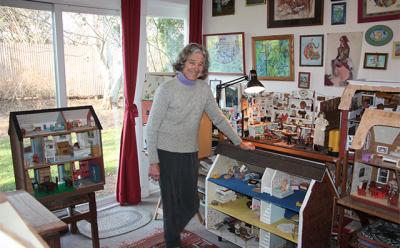House Proud: An East Hampton Artist in Miniatures

There are tiny cabinets, hand-made with care. Bathtubs are repurposed soap dishes, and hand-cut curtains adorn the windows. Much of the furniture is fashioned by hand, with the exception of chairs — chairs are too time-consuming and tough for her hands to handle, seasoned as those hands may be.
Otherwise, though, Irina Ourusoff builds her dollhouses from scratch.
Ms. Ourusoff is an artist from East Hampton who formerly worked as a translator for the United Nations, but who more recently has been a painter, a sculptor, a maker of hooked rugs and quilts, an art teacher, and more. Even at 79, she keeps looking for new creative outlets. Making dollhouses, she said, combines the skills of an architect with those of an interior decorator: “There’s a beautiful detail behind all the houses.”
Only once did Ms. Ourusoff start with a prefabricated, store-bought dollhouse kit, given to her by a friend as a gift. It was nice, she said, but such a pain to put together that she pledged to herself never to bother with a kit again, and she has kept that promise.
The houses she builds begin as simple wooden boxes. The kitchen, dining room, and living room are usually on the first floor, and a flight of steps leads up to a second floor, where there are probably bedrooms, a bathroom, and maybe a specialty room (set aside for music and musical instruments, perhaps). There may also be a third floor, with another bedroom or playroom for the children.
Ms. Ourusoff has also made miniature townhouses, with rooms stacked one on top of another and built into what were originally skinny curio cabinets. These she somehow manages to make even smaller than the dollhouses. If the others have rooms with 10-inch ceilings, the townhouses have perhaps 8-inch ceilings, with everything inside also created to scale.
There are even two stores to go with the dollhouses: a Christmas toyshop and a store that Ms. Ourusoff calls “Abigail’s Sewing Shop.” The latter has the feel of a country antique store, outfitted with merchandise such as spools of thread (which Ms. Ourusoff wound by hand) and tiny baskets. The store’s proprietor uses a miniature ironing board, spinning wheel, and clothing rack, and has filled shelf upon shelf upon shelf with amazing little odds and ends.
Notable among the dollhouses is a replica of a real house on Division Street in Sag Harbor, the tall green one with the white scalloping that’s on the right-hand side of northbound Route 114. The little copy is as striking as the big original, although its interior is imagined.
In Ms. Ourusoff’s dollhouses, the walls are covered with real wallpaper. The linoleum in the kitchens is actual linoleum. The paintings hanging on the walls are her own original works of art.
“It’s a disaster when I finish one. If you’ve ever done puzzles, you know,” she said. “To me, it’s difficult to finish something and to start brand-new again. When I finish something, I’ve put my whole soul there, and I have to start another one.”
Ms. Ourusoff often constructs things in multiples, for instance building three sofas at once, gluing one piece at a time and moving onto another while the glue on the first one sets. She works with wood, clay, cloth, felt, and more, concurrently building and decorating, because, she said, the process of collecting accessories — things like dishes, lamps, and, yes, the chairs she prefers not to make herself — is very time-consuming.
“You start collecting. Mainly what you start collecting, at garage sales and antiques stores, is anything that is tiny and difficult to find. The smaller, the better. You have to find real things, but tiny,” she said, offering up a doll-sized candlestick and teapot as examples.
Creating and collecting miniatures emerged as an art form and pastime in the 18th century and became popular again in the early 1970s, according to the website of the International Guild of Miniature Artisans. Today, what with the Internet, there is a huge market, with national associations, museums, and conventions for collectors and artists. Listings for dollhouse furnishings, kits, and accessories number a half million on eBay. But Ms. Ourusoff does not shop on the Internet, instead preferring to find things in person or make them herself.
The artist, who sells her dollhouses for anywhere from $75 to $500 and can create them to a client’s particular specifications, recommended reading “The Mouse Mansion,” by Karina Schaapman, a children’s book that adults interested in miniatures will enjoy as well. With detailed photographic illustrations, it documents an epic maze of a dollhouse, straight out of a fairy tale, built for a colony of mice.
As a child, Ms. Ourusoff never had a dollhouse of her own. Now she has as many as she wants, and “I’m blissfully happy,” she said.
